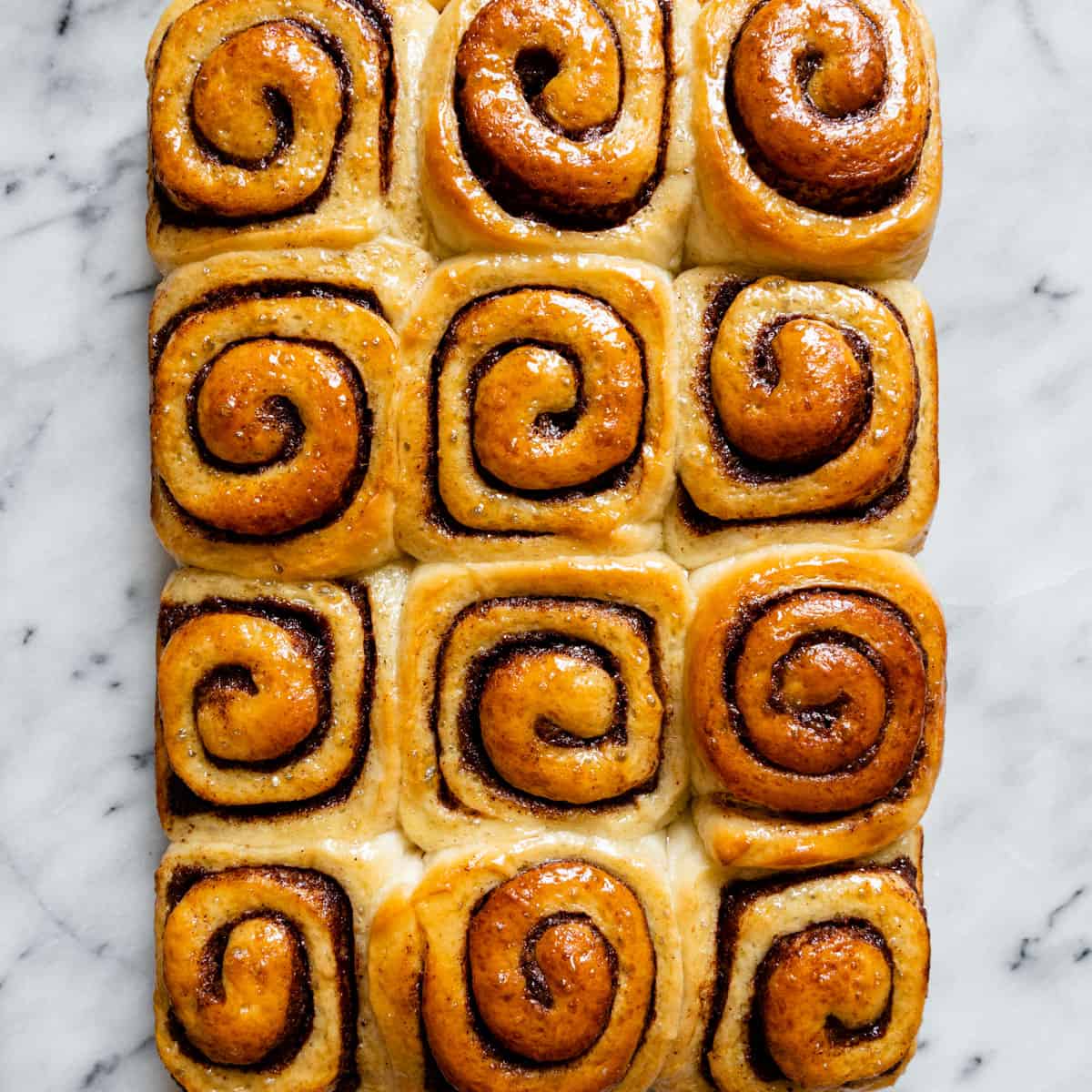
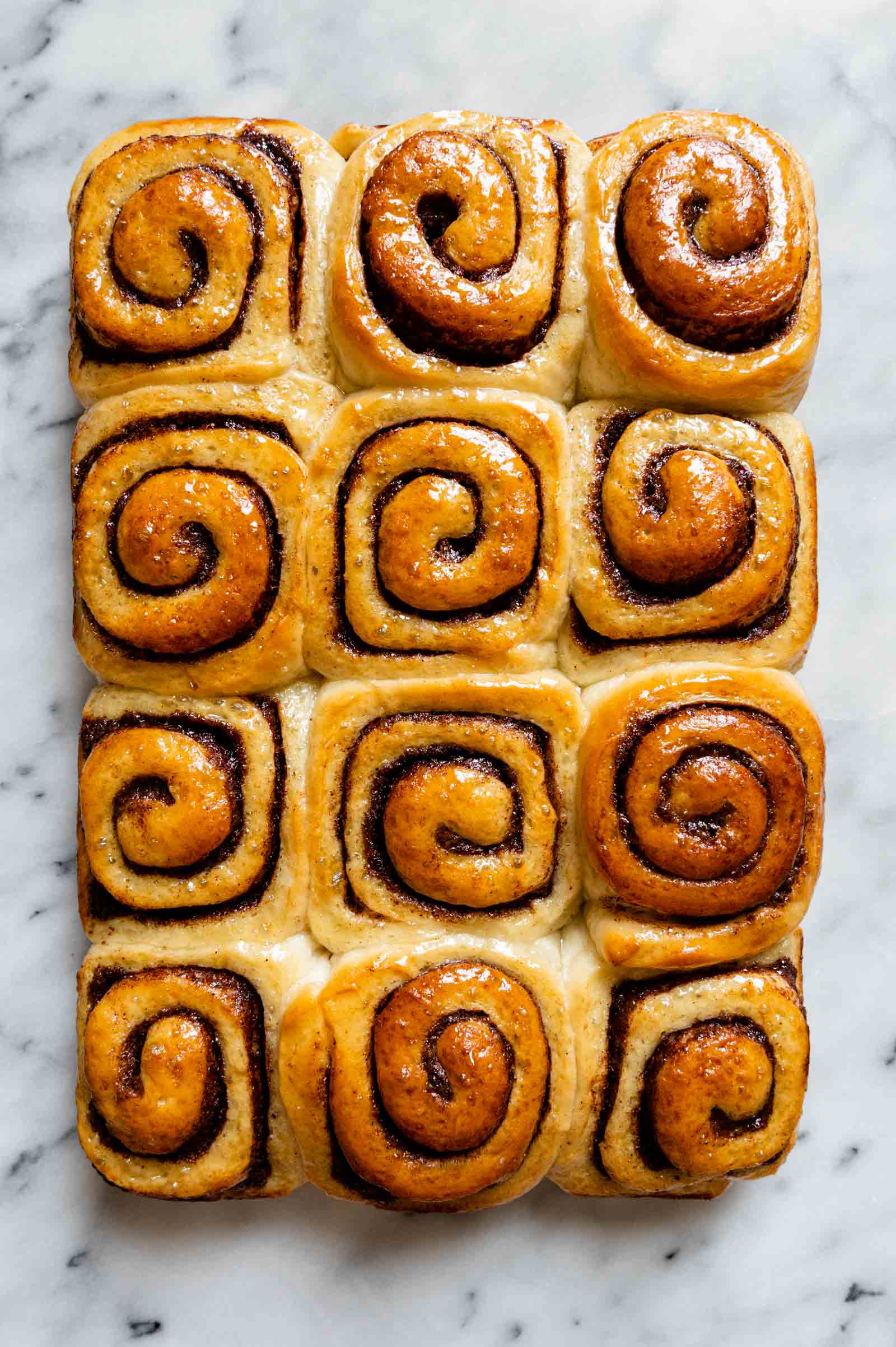
Thank you to Bob’s Red Mill for sponsoring this post!
Whenever I visit my in-laws in England, they ask me to make a batch of cinnamon rolls (in addition to dumplings, of course). Although this tradition has been going for several years now, I cannot believe I haven’t shared a cinnamon roll recipe here yet!
Ever since I started making Asian-style milk bread a few years ago, I’ve been using that style of dough in nearly all my enriched breads. These milk bread cinnamon rolls are no exception. Asian-style milk bread often uses tangzhong (湯種) to give the bread airy texture.
Tangzhong is a Chinese technique of heating flour and water together to form a paste that is then added to the dough. The paste allows more water to be absorbed into the flour, yielding bread with softer texture. I love how tangzhong makes these cinnamon rolls more airy.
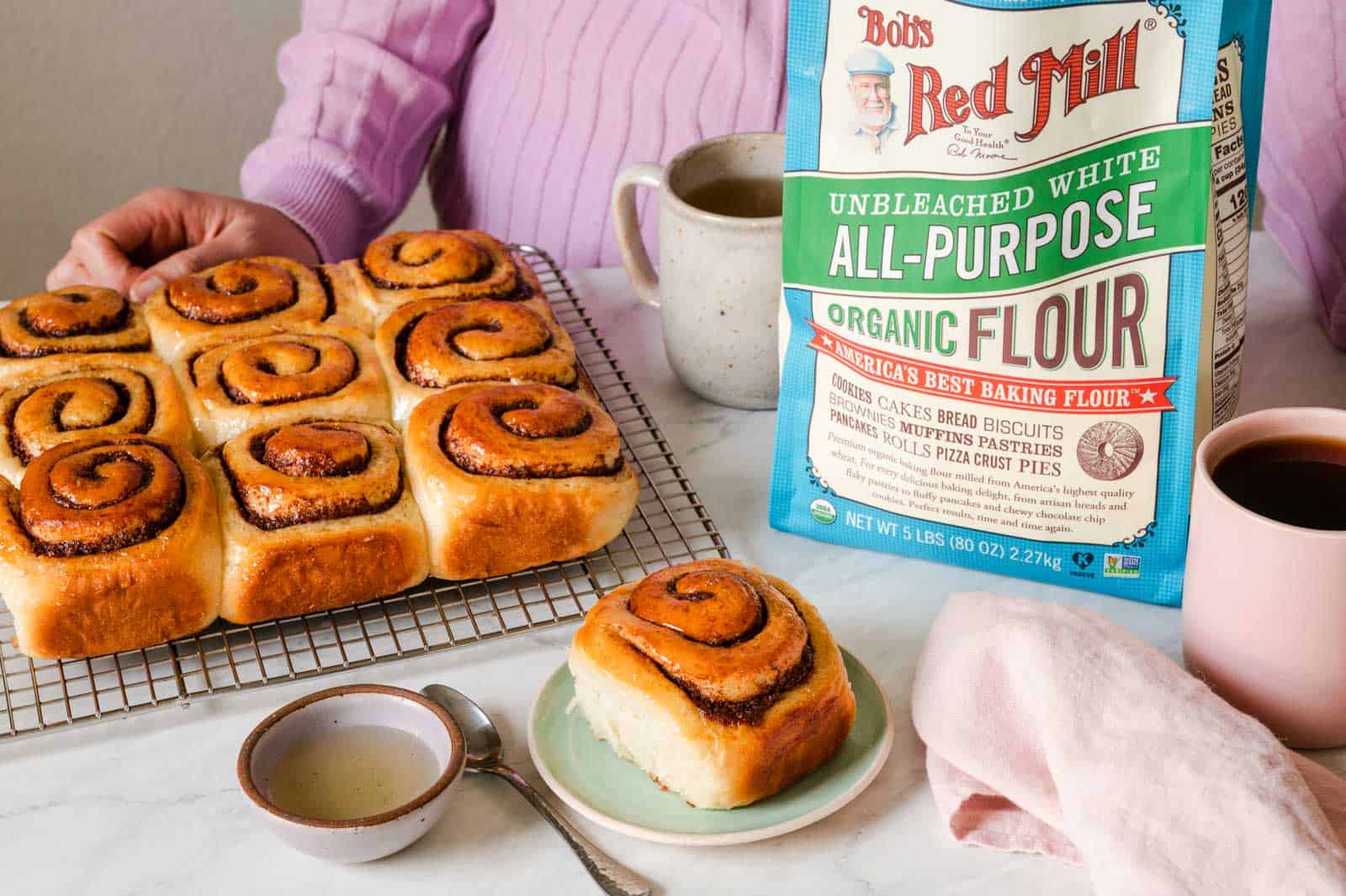
Most cinnamon roll recipes will call for a cream cheese frosting or an icing made of powdered sugar. I often find these toppings to be too sweet or too decadent. I much prefer something that’s tangy and sweet. When I make cinnamon rolls in the UK, I typically make a tart lemon glaze to brush over the rolls.
When I was testing these milk bread cinnamon rolls one day, I happened to also have a fresh batch of pomegranate molasses. Out of curiosity, I glazed the rolls with the pomegranate molasses and was pleasantly surprised by how well everything worked together. In addition to sweet and tangy flavor, the pomegranate molasses also added welcome fruity notes to the cinnamon rolls. They were such a delight!
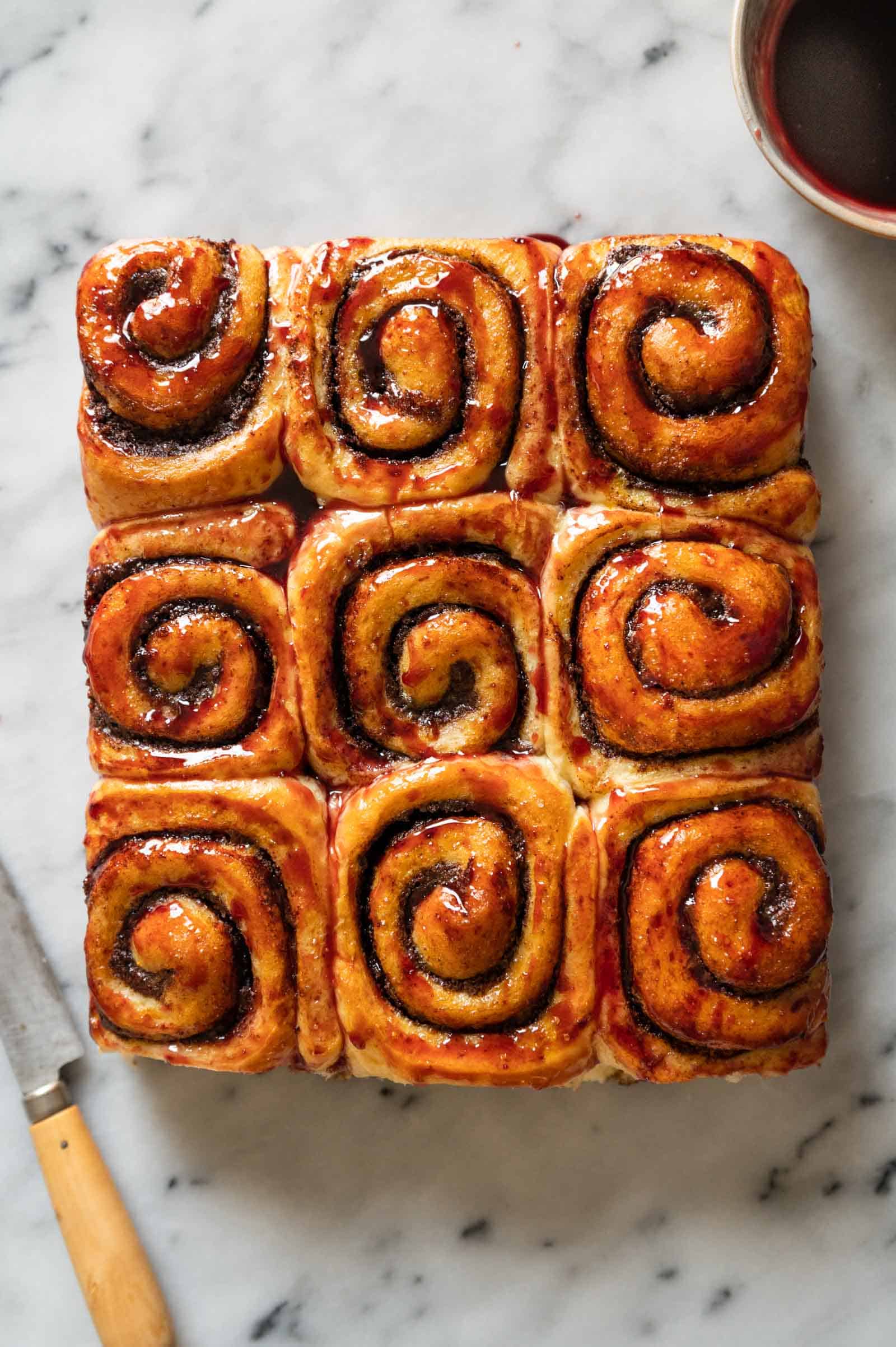
HOW TO MAKE MILK BREAD CINNAMON ROLLS
INGREDIENTS OVERVIEW FOR DOUGH
For the dough, I am using Bob’s Red Mill Unbleached White Organic All-Purpose Flour. It is a very versatile dough that I use in many of my bread recipes, such as Japanese milk bread and scallion bread. I also use the flour for dumpling wrappers, Chinese chive pockets, and even noodles! It is a true all-purpose flour that delivers good results for all the different types of recipes I make. Plus, I can find Bob’s Red Mill in all of my neighborhood grocery stores! Mama Lin loves using the all-purpose flour, too.
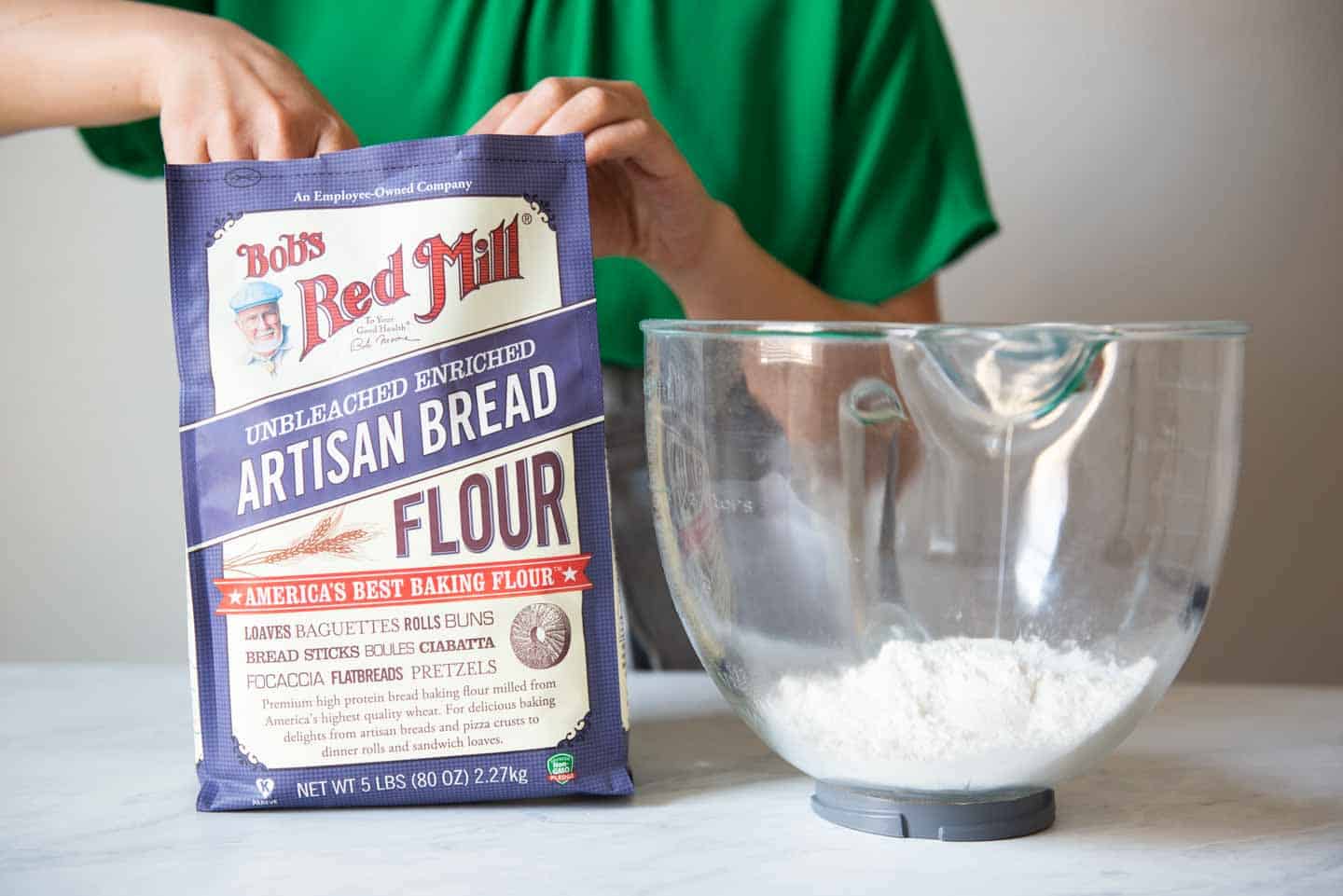
If you want rolls with a chewier crumb, you can substitute the all-purpose flour with Bob’s Red Mill Artisan Bread Flour, which has a higher protein content.
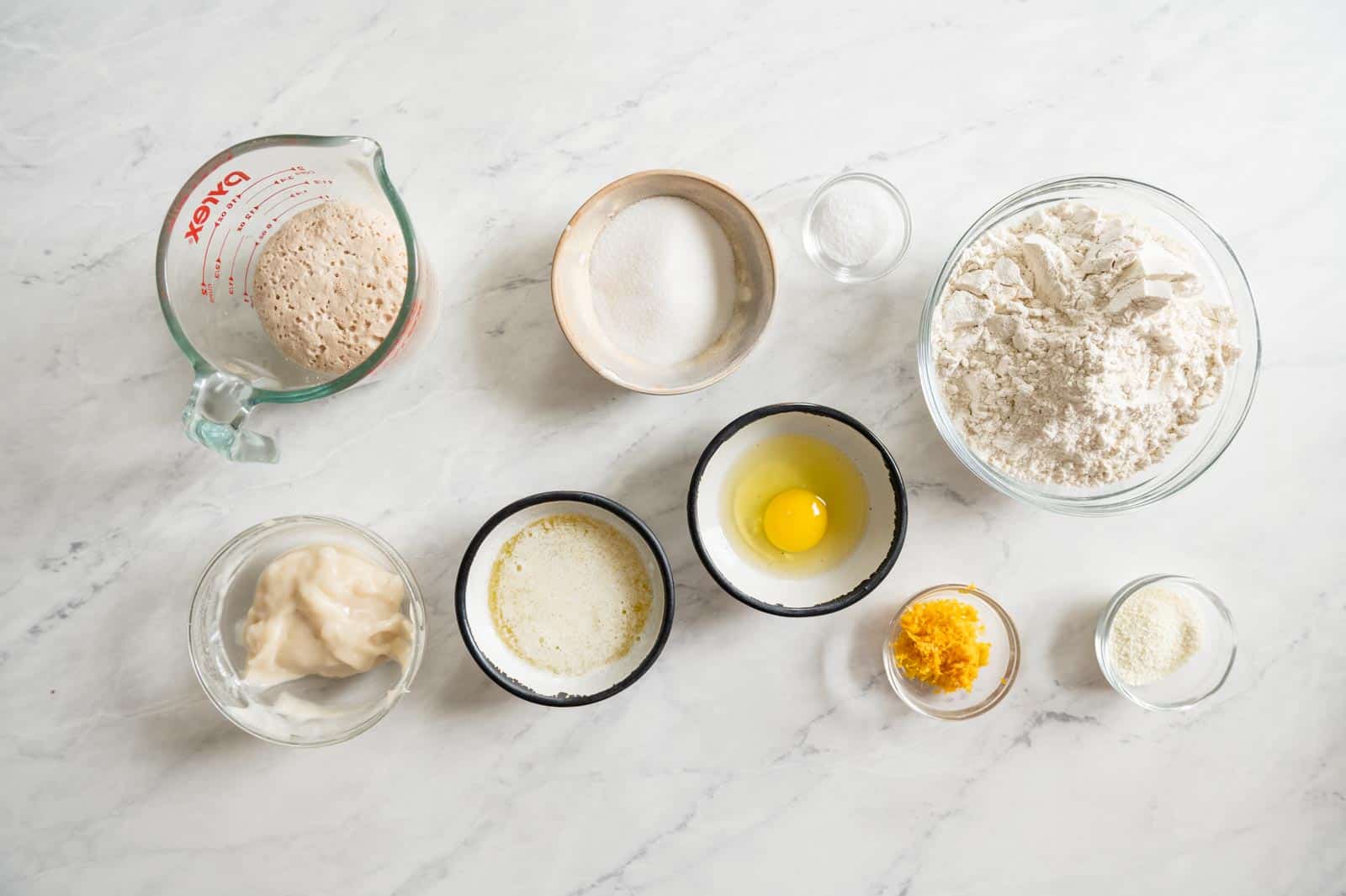
Besides the tangzhong that I mentioned above, the dough is enriched with milk, butter, and an egg. For my milk bread recipes, I typically use sweetened condensed milk to add more milky flavor. However, many followers have asked me about alternatives to condensed milk. That’s why I’m using a combination of milk powder and sugar in this milk bread cinnamon roll recipe.
As usual, I’m using active dry yeast as the leavening agent, but you can use instant yeast instead. I explain this further below. Finally, I added the zest of 2 lemons to the dough, which gives the rolls a subtle bright flavor.
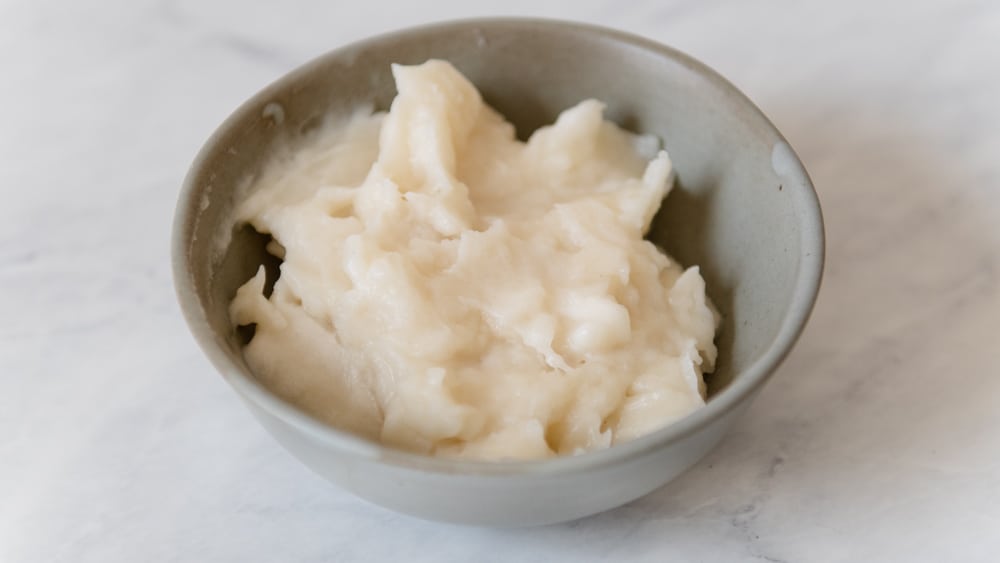
MAKE THE TANGZHONG
When making the dough for these milk bread cinnamon rolls, I usually start by preparing the tangzhong. I like to let it cool slightly before mixing it with other ingredients. You can prepare the tangzhong on the stove or in the microwave. If you’ve never made tangzhong before, you should make it in a saucepan first. The saucepan method gives you more control over the heat source and you’ll be less likely to overheat the paste.
If you’re working from the stove, whisk together some water and all-purpose flour in a saucepan. Then, you’ll heat the mixture over medium-low heat, stirring frequently until a paste forms. It will take about 1 to 2 minutes. Transfer to a bowl to cool.
For the microwave method, whisk the flour and water in a bowl. Then, heat it on high for 30 seconds or so. Give it a stir. It’s likely still very runny, so microwave it for 10 seconds more and stir again. If you have a pretty thick paste, you can stop. Otherwise, keep heating the tangzhong at 5-second intervals and stir until you get a paste.

ACTIVATE THE YEAST (FOR ACTIVE DRY YEAST)
Heat the milk in the microwave for about 30 to 40 seconds until the temperature is about 105ºF to 120ºF. Then, add a tablespoon of sugar into the milk and stir in the yeast. Let this mixture sit for 5 to 8 minutes, until a layer of foam forms at the top, an indication that the yeast is active.
If you’re using instant yeast, you don’t need to activate it in warmed milk. You can just add the yeast to the bowl of your stand mixer, along with the other ingredients.
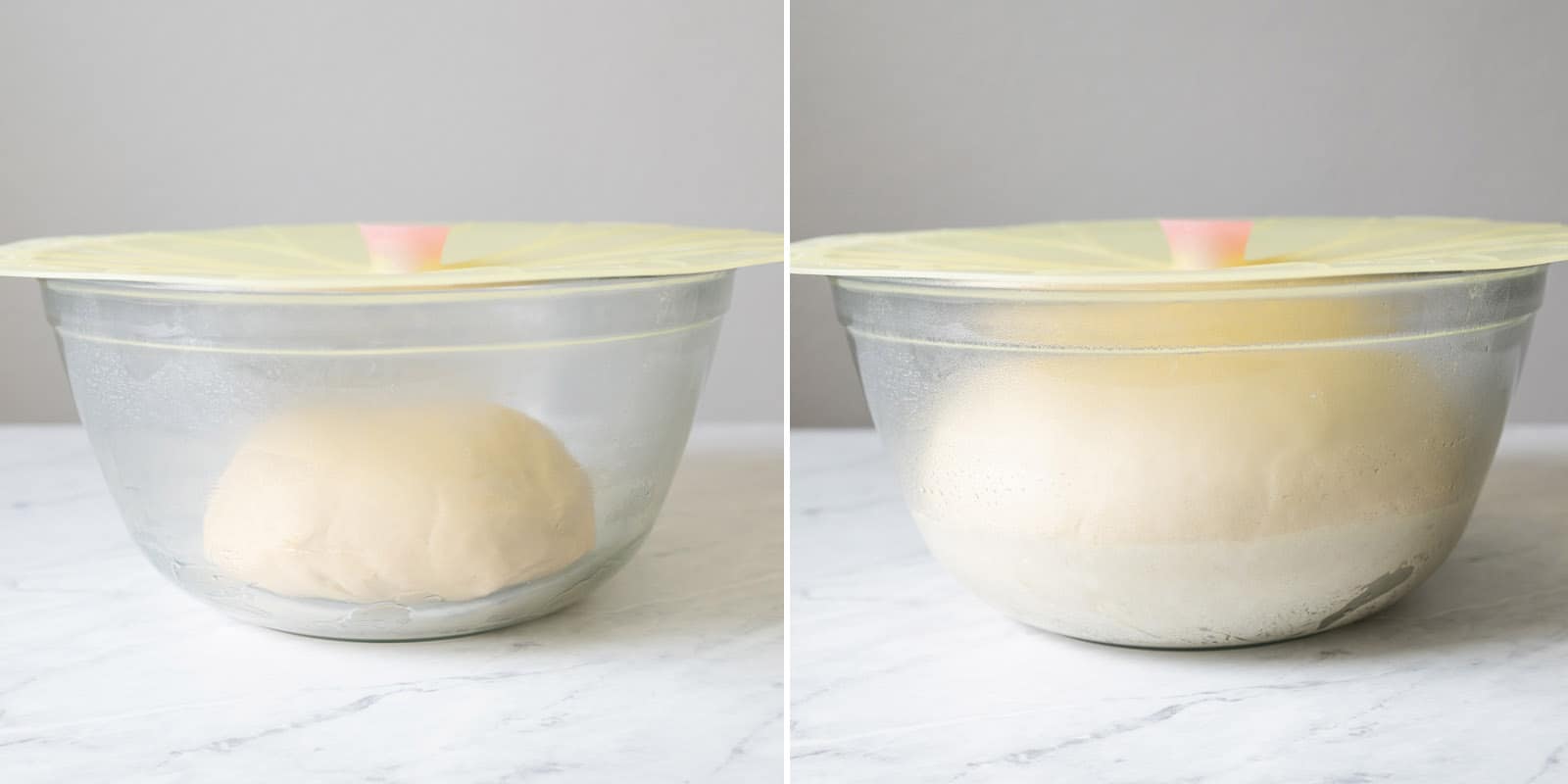
FINISH MAKING DOUGH
Before I gather all the other ingredients into the bowl of my stand mixer, I also like to melt the butter and let it cool for 5 to 10 minutes.
Add all the ingredients for the dough into the bowl of a stand mixer: flour, sugar, milk powder, salt, egg, lemon zest, tangzhong, milk/yeast mixture, and melted butter. Mix the dough on low until you don’t see any loose flour on the sides of the bowl. This should take 30 seconds to 1 minute. Then, increase the speed to medium-low and work the dough for 7 minutes. You may need to scrape down the sides of the bowl occasionally.
With lightly floured hands, touch the dough. If it’s feeling very sticky, work in another 1 to 2 tablespoons of flour.
Scrape the dough out of the bowl onto a lightly floured surface and knead a few times. If the dough is feeling tacky, lightly dust your hands with flour. Then, shape the dough into a ball and place it inside a lightly greased bowl. Cover the bowl with a damp towel or silicone lid and let it rise in a warm place for about an hour, until the dough doubles in size.
MAKING DOUGH BY HAND
This is quite a wet dough, so it will be messy to knead by hand though not impossible. Add all the ingredients for the dough in a bowl. Using a wooden spoon, mix everything together until it looks like all the liquids have absorbed into the flour (see photo below).

Lightly dust the work surface with flour. Have a bench scraper ready to scrape wet dough off the counter.
Transfer the dough onto the floured surface. Knead it for a few times. Then grab onto the dough and stretch it towards you. Fold it over. Repeat the stretch and fold process for several minutes. Use the bench scraper to scrape off dough that’s been stuck. It won’t be easy at the start because the dough is very wet and sticking to your fingers. Just keep going as best you can.
After a few minutes, I grab the dough, slap it on the counter, stretch it towards me, and fold it over. Then I repeat this process until the dough no longer feels like it’s really sticky on my hands. When kneading dough by hand, I don’t pay attention to how long I’m kneading the dough. Rather, I’m more focused on how the dough feels. By the end, the dough will feel slightly tacky but not overly sticky.
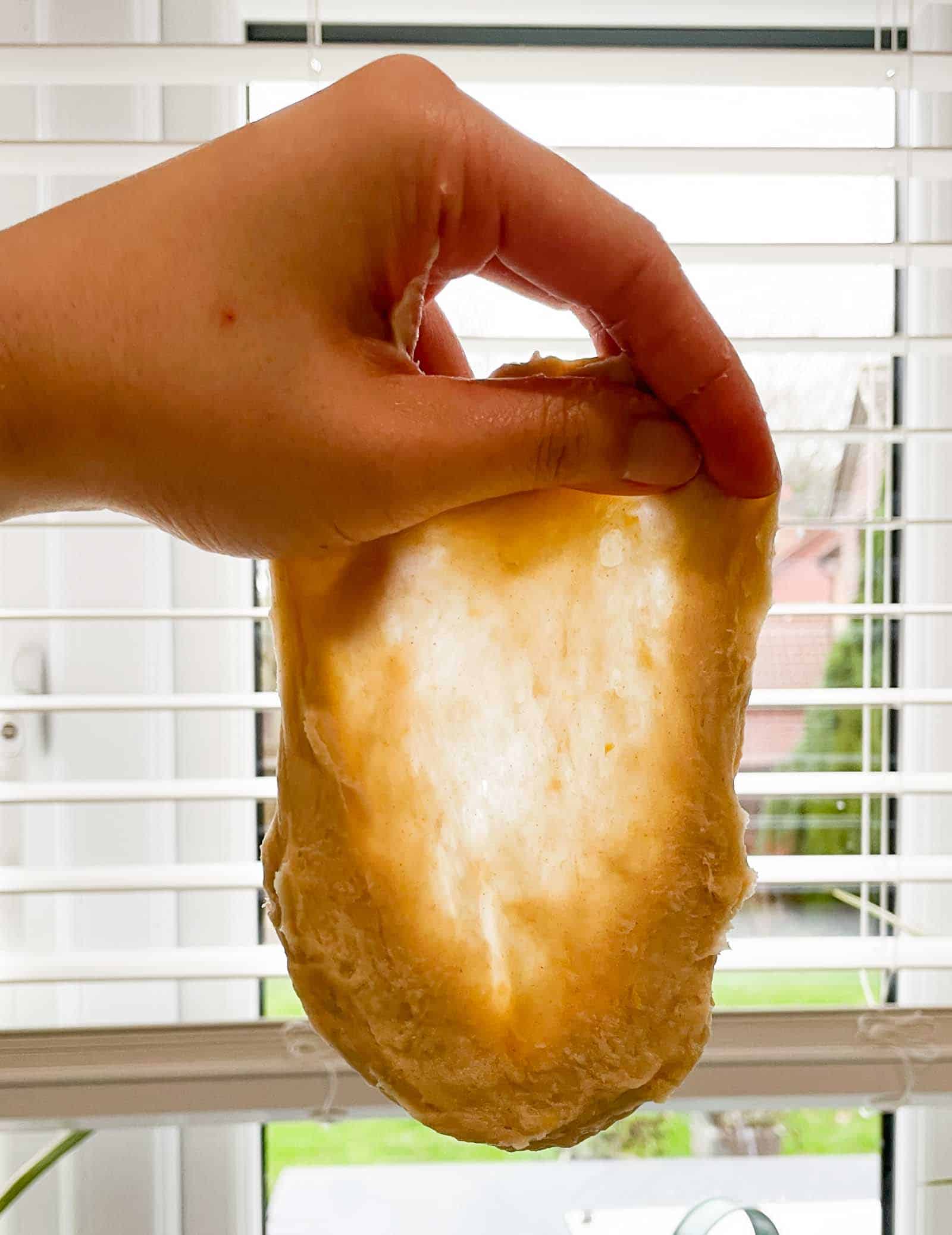
Finally, I do the window pane test to make sure the gluten has been properly developed. I take a golf-ball size of dough and stretch it out the center of the piece of dough. If I can stretch it out to a thin layer and I see light coming through, the dough is ready for the first rise.
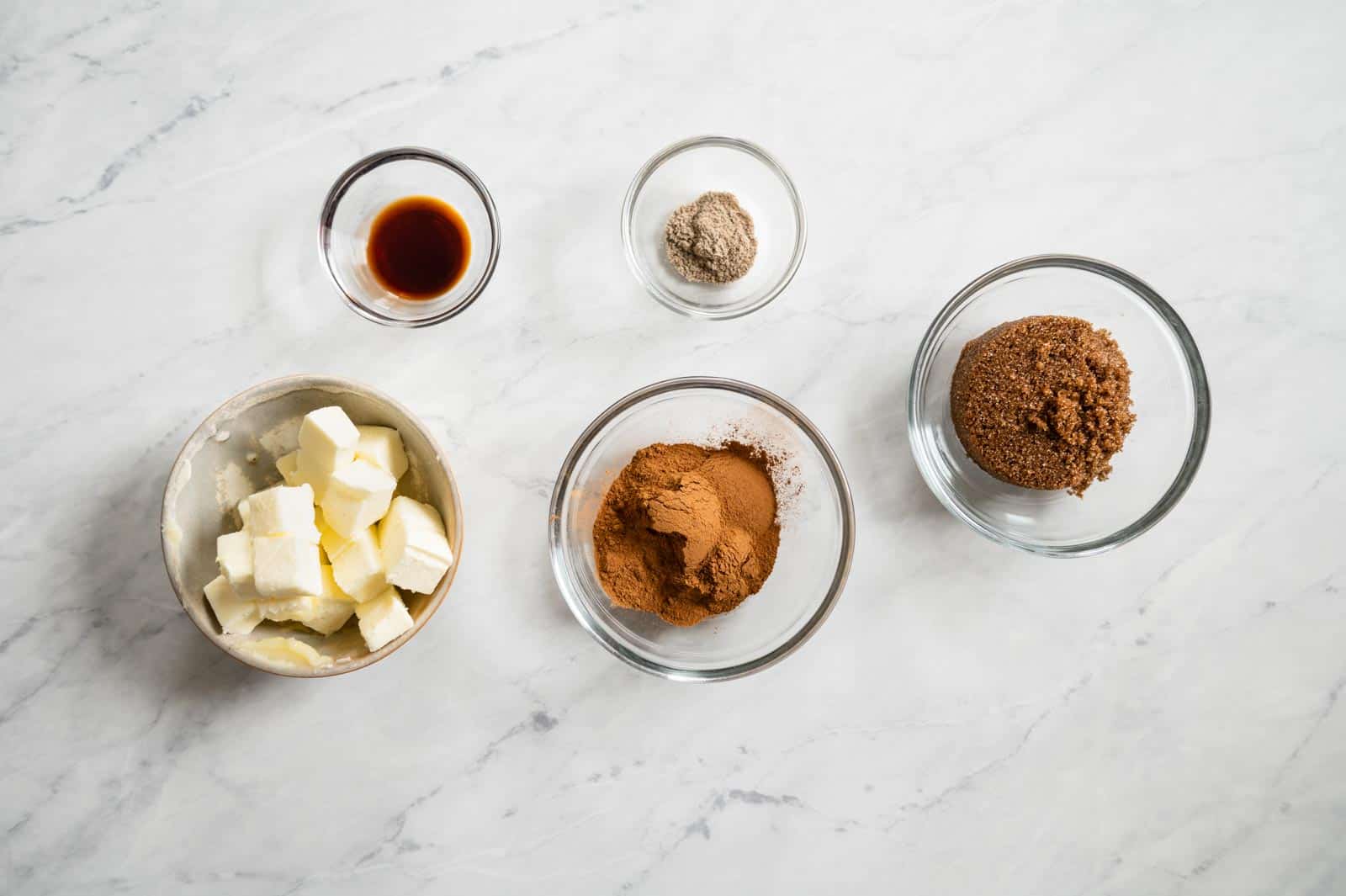
INGREDIENTS OVERVIEW FOR FILLING
I tried many iterations of the filling and found that it tastes best with a lot of cinnamon and brown sugar instead of regular granulated sugar.
You’ll want the butter to be at room temperature and cut into cubes so that it’s easy to cream with the brown sugar. I’ve used dark brown sugar, but light brown sugar works as well.
I used 4 tablespoons of cinnamon to ensure that I get good cinnamon flavor with every bite. I also added 1 teaspoon of freshly ground cardamom (from green cardamom pods) so that the filling has more complex flavor. Finally, I added 1 teaspoon of vanilla extract for more flavor.
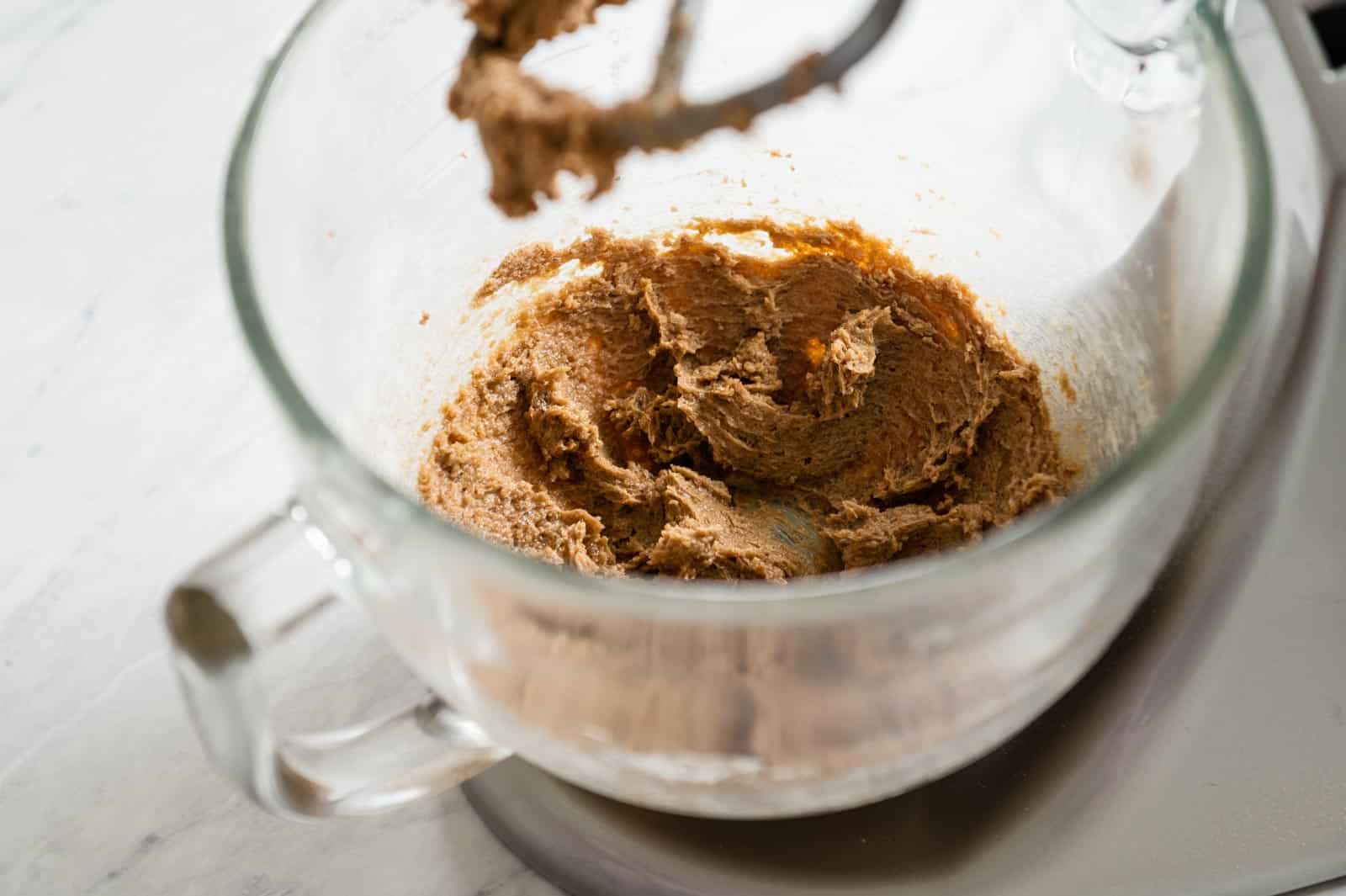
MAKE THE FILLING
Fit the mixer with the paddle attachment. Cream the butter and sugar on low for about 30 seconds to a minute. Scrape down the butter along the sides of the bowl, if necessary. Increase the speed to medium-low and mix the butter for another 1 to 2 minutes, until the sugar is well incorporated and the butter is starting to look fluffy (see photo above).
Add the cinnamon, cardamom, and vanilla and mix on low until the cinnamon is well incorporated. Transfer the filling to a bowl.
PREPARE LEMON GLAZE
The amount of lemon juice and sugar you use depends on the lemons you use and the level of tartness you like. I found when using Meyer lemons, I liked using equal parts lemon juice and granulated sugar. Meyer lemons tend to be sweeter and less acidic than conventional lemons. When using regular lemons, I liked adding slightly more sugar (1/3 cup lemon juice to 1/2 cup sugar).
Add the lemon juice and sugar to a saucepan. Give everything a stir until the sugar dissolves. Then, heat the saucepan over medium-high heat until the liquid bubbles. Reduce the heat to medium-low and let the glaze simmer for another 2 to 3 minutes. Don’t let the glaze simmer for much longer as it can burn! Remove the saucepan from heat and let the glaze cool.
SHAPE THE ROLLS
Grease a 9×13-inch baking pan with some oil. Lay a piece of parchment paper in the pan, making sure there’s about 1.5 to 2 inches of overhang on the long sides. The oil helps keep the parchment in place. You can also use binder clips to clip down the paper if it gets in the way. Just make sure to remove the clips before you bake the rolls.
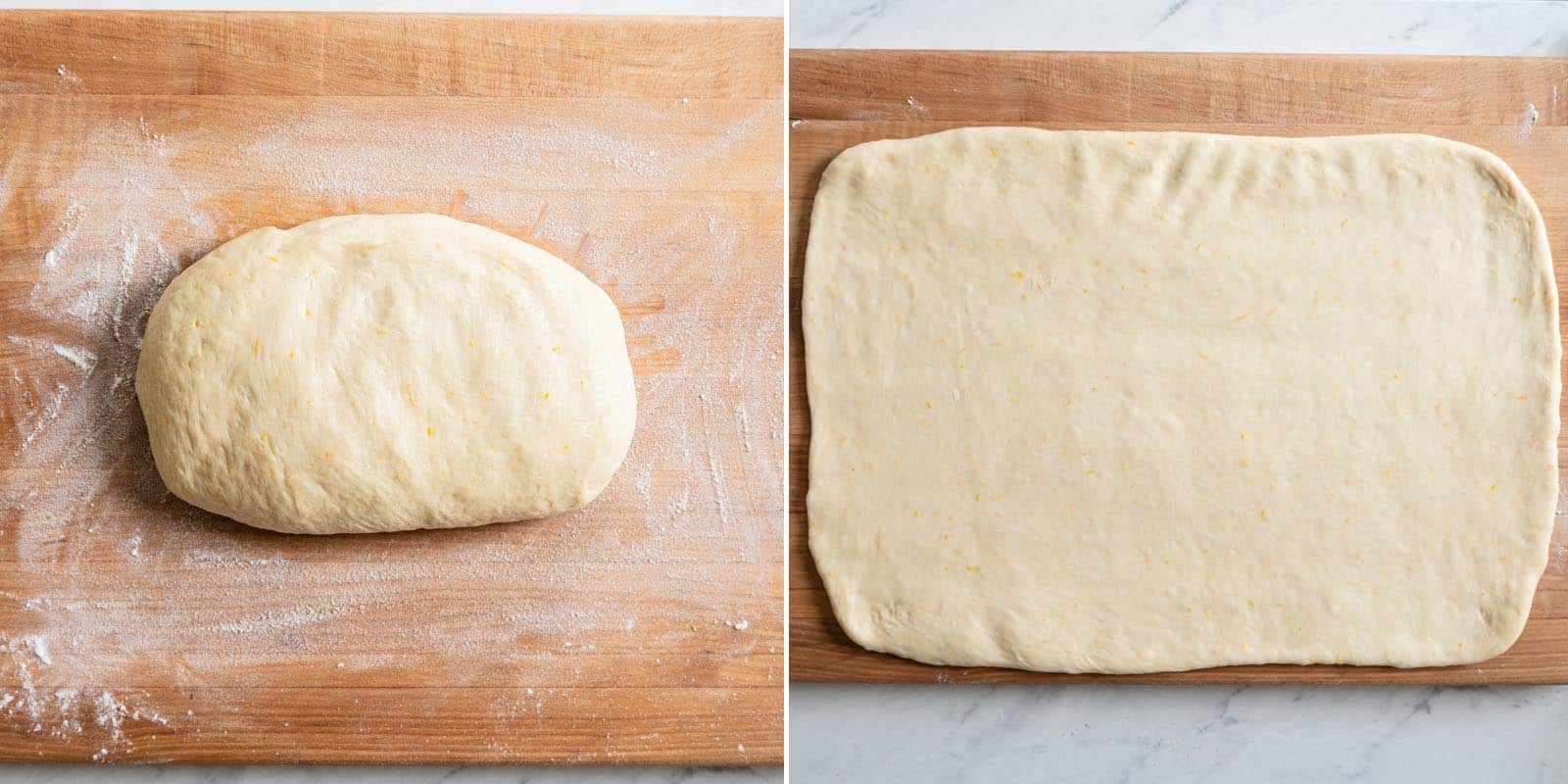
Punch down the risen dough to release excess air. Turn the dough over a lightly floured surface and shape into an oval. If the top of the dough feels greasy, lightly sprinkle some flour on top.
Roll out the dough to a 18×12-inch rectangle.

Then, scoop out the filling and spread it all over the rectangle, making sure that the filling reaches the edges. Grab onto a long edge of the dough and roll up the dough into a log. As you roll up the dough, make sure the sides are rolling up straight and not caving in. That helps to ensure that the rolled up dough is evenly thick throughout. I usually like to use a tape measure to ensure that the long is still roughly 18 inches long.
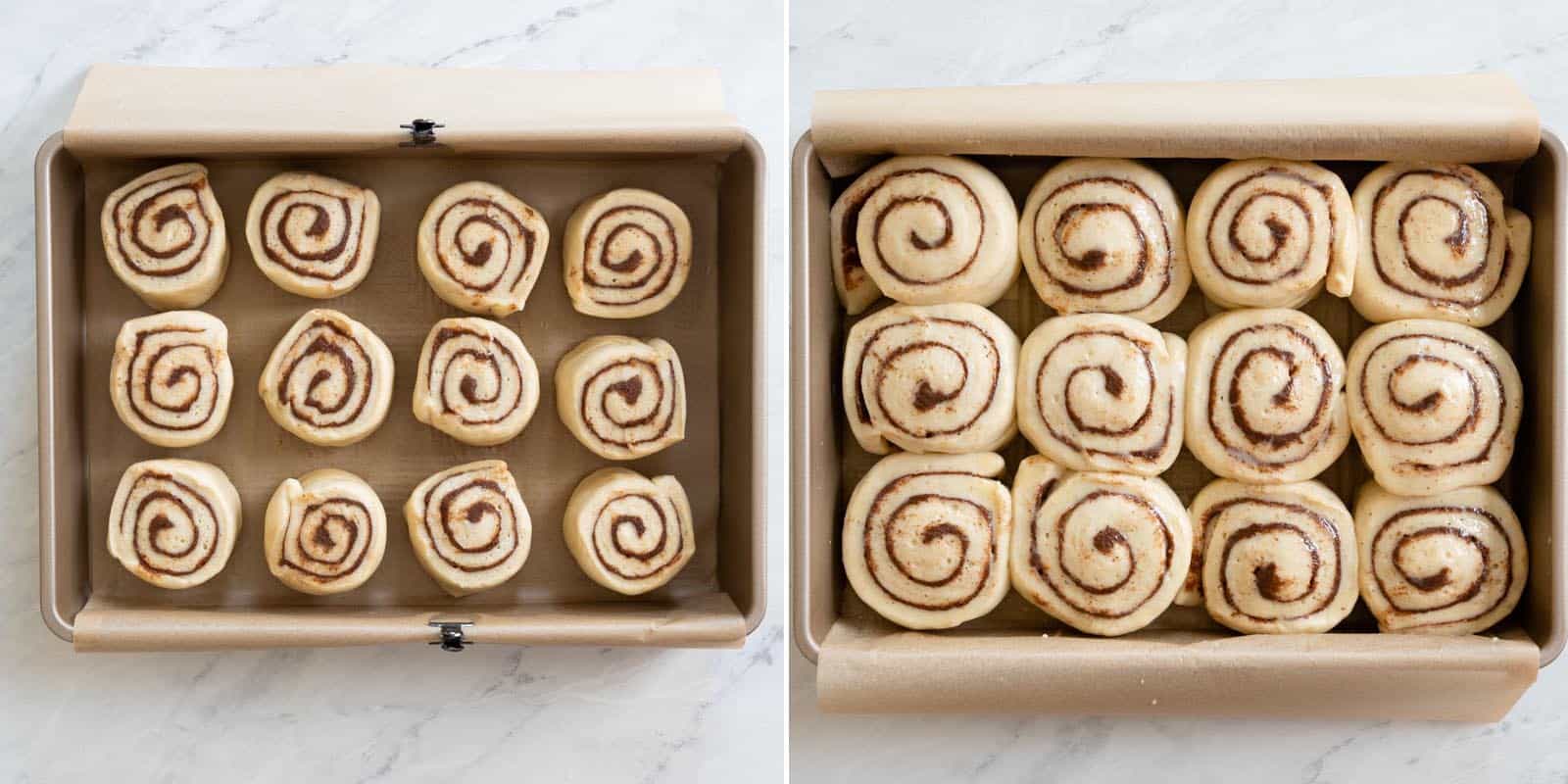
Slice the log into 12 equal pieces of about 1.5 inches wide. I always use a sharp serrated bread knife for this. You can also use another kind of sharp knife or dental floss.
Place the rolls cut side down inside the parchment-lined pan. Cover the rolls with plastic or a damp towel. Let the rolls rise in a warm place for 45 minutes to 1 hour, until they double in size. The time depends on how hot or cold the environment is. During the winter time, it can take as long as 1 hour 15 minutes to double in size.
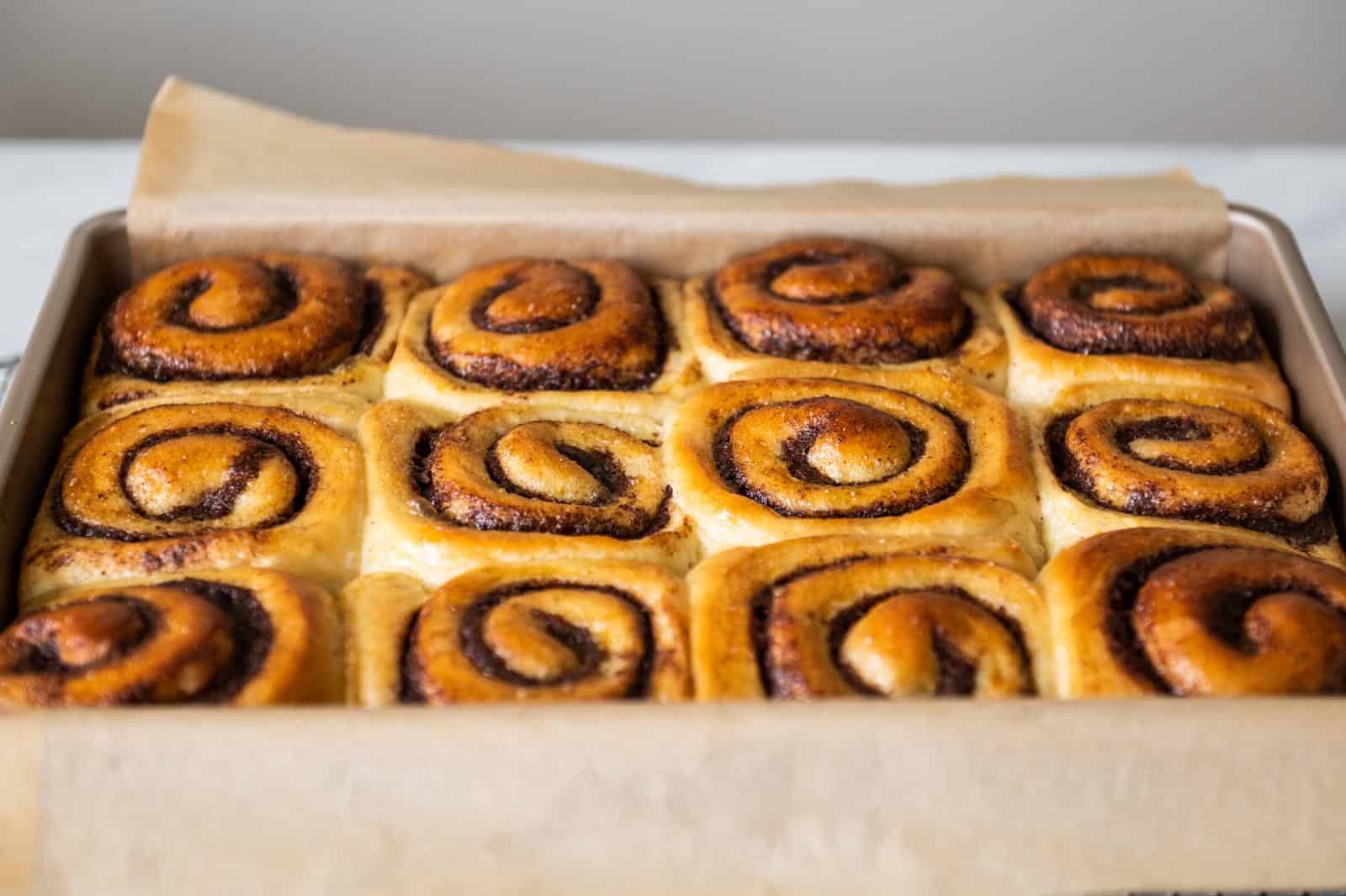
BAKE THE ROLLS
Preheat the oven to 350ºF. Position an oven rack in the center position.
For the photographs, I brushed a bit of egg wash over the risen rolls so that they look more evenly brown on the top. Especially since we’re covering the rolls with a translucent glaze, the color of the rolls are more noticeable. It is not necessary.
Bake the rolls at 350ºF for 23 to 25 minutes. The rolls should look lightly golden on top. If you are using a cast iron or a glass baking pan, your rolls may take an extra few minutes to cook.
Let the rolls cool in the pan for 5 to 10 minutes. Brush the lemon glaze or pomegranate molasses onto the rolls. Grab onto the parchment paper on the sides and lift the rolls out from the pan and onto a cooling rack. Enjoy the rolls while they’re still warm.
HOW TO PREPARE CINNAMON ROLLS AHEAD
If you want to break up the work, let the dough rise in the fridge overnight. You can either add the dough to the fridge right after you’ve kneaded the dough or right after you line the baking pan with the cut rolls. Do not let the dough rise on your counter before transferring it to the fridge. Similarly, you don’t need the dough to reach room temperature before shaping the rolls or baking them.
MORE RECIPES WITH BOB’S RED MILL FLOUR
- Baked Char Siu Bao (BBQ Pork Buns, 叉燒包)
- Egg Noodles
- Japanese Milk Bread
- Gluten-Free Crystal Skin Dumplings

Milk Bread Cinnamon Rolls
Ingredients
Tangzhong
- 3 tablespoons (30 grams) all-purpose flour
- 1/2 cup (115 grams) water
Dough
- 2/3 cup (150 grams) whole milk
- 4 tablespoons (48 grams) granulated sugar divided
- 2 1/4 teaspoons (7 grams) active dry yeast (see note 1)
- 2 2/3 cups (440 grams) all-purpose flour
- 1 teaspoon (3 grams) kosher salt
- 5 tablespoons (70 grams) unsalted butter melted
- 2 tablespoons (10 grams) instant milk powder (optional, see note 2)
- 1 large egg
- zest of 2 lemons about 1 1/2 tablespoons
Filling
- 1/2 cup (110 grams) unsalted butter cubed and softened at room temperature
- 1/2 cup (100 grams) brown sugar light or dark
- 4 tablespoons (20 grams) ground cinnamon
- 1 teaspoon freshly ground cardamom
- 1 teaspoon vanilla extract
Lemon Drizzle
- 1/3 cup lemon juice about 2 large lemons, see note 3 about using Meyer lemons
- 1/2 cup (50 grams) granulated sugar
Egg Wash (Optional)
- 1 egg
- 1 tablespoon milk or water
Equipment
- saucepan
- fork/spoon
- stand mixer
- mixing bowls
- 9×13-inch baking pan
- parchment paper
Instructions
Make the Tangzhong
- You can make the tangzhong in a saucepan or the microwave. For the saucepan method, whisk the flour and water together until the flour dissolves. Place the saucepan over medium heat and stir the mixture frequently. In about 30 seconds to 1 minute, the flour will start to thicken. Stir constantly until the watery liquid absorbs into a thicker paste. Turn off the heat and transfer the tangzhong to a bowl to cool.
- For the microwave method, whisk the flour and water together. Then, heat the mixture for 30 seconds on high. Take the bowl out of the microwave, stir everything and check the consistency of the mixture. If the tangzhong is still quite runny, microwave it for another 10 seconds and stir. If it has formed already, stir and let it cool. Otherwise, heat the mixture at 5-second intervals, stirring in between, until you get a thick paste. Be patient and resist the urge to stick the tangzhong in the microwave and heat it for a longer period. The tangzhong can easily overheat, leaving you with a stiff block of cooked flour.
Prepare the Dough
- Lightly grease a large mixing bowl with oil. Set it aside.
- In a microwave-safe bowl, heat the milk in the microwave on high for about 30 to 40 seconds. Use a thermometer to check the temperature of the milk. It should be somewhere around 105ºF to 120ºF. If the milk isn’t hot enough yet, heat it again for 5 to 10 seconds. If the milk is too hot, quickly whisk the milk and let it cool for several minutes.
- Add 1 tablespoon of sugar and yeast to the milk. Stir to hydrate the yeast. Let it sit for 5 to 8 minutes while you prepare the other ingredients. After 5 to 8 minutes, you should see a layer of foam on the top at least 1/4 inch thick (an indication that the yeast is active).
- In the bowl of a stand mixer, add the all-purpose flour, sugar, milk powder, salt, egg, lemon zest, tangzhong, milk/yeast mixture, and melted butter.
- Fit the mixer with the dough hook. Mix the dough on low until you don’t see any loose flour on the sides of the bowl. This should take 30 seconds to 1 minute. Then, increase the speed to medium-low and work the dough for 7 minutes. You may need to scrape down the sides of the bowl occasionally.
- Scrape the dough out of the bowl onto a lightly floured surface and knead a few times. If the dough is feeling tacky, lightly dust your hands with flour.
- Shape the dough into a ball and place inside the greased mixing bowl. Cover the bowl with a damp towel (or a silicone lid) and let it rise in a warm place for about 1 hour, until the dough doubles in size.
Prepare Filling
- Rinse out the bowl of the stand mixer and dry with a towel. Add the butter and brown sugar to the bowl.
- Fit the mixer with the paddle attachment. Cream the butter and sugar on low for about 30 seconds to a minute. Scrape down the butter from the sides of the bowl, if necessary. Increase the speed to medium-low and mix the butter for another 1 to 2 minutes, until the sugar is well incorporated and the butter is starting to look fluffy.
- Add the cinnamon, cardamom, and vanilla and mix on low until the cinnamon is well incorporated. Transfer the filling to a bowl.
Prepare Lemon Glaze
- Add equal parts lemon juice and granulated sugar to a saucepan. Give everything a stir until the sugar dissolves.
- Heat the saucepan over medium-high heat until the liquid bubbles. Reduce the heat to medium-low and let the glaze simmer for another 2 to 3 minutes. Don’t let the glaze simmer for much longer as it can burn. Remove the saucepan from heat and let the glaze cool.
Shape Cinnamon Rolls
- Grease the baking pan with some oil. Lay a piece of parchment over the pan, making sure there’s about 1 1/2 inches of overhang along the longer sides. The oil should help keep the parchment in place.
- Punch down the dough to release excess air. Turn the dough over a lightly floured surface and shape it into a large oval. If the top of the dough is greasy, lightly sprinkle some flour on top.
- Roll out the dough to a 18×12-inch rectangle.
- Scoop out the filling and spread it onto the dough rectangle. Make sure to spread the filling up to the edges of the dough rectangle.
- Grab onto a long edge of the dough and roll up the dough into a log. As you roll up the dough, make sure the sides are rolling up straight and not caving in. That helps to ensure that the rolled up dough is evenly thick throughout. I usually measure the log here to make sure it’s about 18 inches long.
- Slice the log into 12 equal pieces, about 1.5 inches wide. I like using a sharp serrated bread knife for this. You can also use any sharp knife or dental floss.
- Place the rolls cut side down inside the parchment-lined pan. Cover the rolls with plastic or a damp towel. Let the rolls rise in a warm place for 45 minutes to 1 hour, until they double in size. The time depends on how hot or cold the environment is. During the winter time, it can take as long as 1 hour 15 minutes to double in size.
Bake the Rolls
- Preheat the oven to 350ºF and arrange an oven rack to the middle position.
- If you want to make the egg wash, Make the egg wash by whisking an egg with 1 tablespoon of water or milk. Brush a thin layer of egg wash over the rolls.
- Bake the rolls for 23 to 25 minutes, until the tops of the rolls are lightly golden brown. (See note 5) Let the milk bread cinnamon rolls cool in the pan for 10 minutes.
- Then, grab onto the parchment paper and lift all the rolls out of the pan and transfer to a cooling rack.
- Brush the lemon glaze over the rolls. Let the rolls cool for another 5 minutes before serving. Enjoy the rolls warm.
- Store any remaining rolls in an airtight container at room temperature. They will keep for several days. To reheat, microwave the rolls on high heat for 10 to 15 seconds. You can also heat them in the oven at 325ºF for 8 to 10 minutes.
Notes
- You can use instant yeast instead of active dry yeast. If using instant yeast, you don’t need to activate it in warm milk. Just add the instant yeast the same time you add the all-purpose flour.
- The purpose of the milk powder is to give the rolls more milky flavor. You can omit the milk powder. In other milk bread recipes, I use condensed milk. If you also want to use condensed milk instead, swap out the 2 tablespoons of milk powder and 3 tablespoons of sugar with 4 tablespoons (or 80 grams) of condensed milk. Some people have asked how you can replace the seemingly dry sugar with condensed milk. The reason is because sugar liquefies once you mix it in with the wet ingredients in the dough. If you use condensed milk, the dough won’t suddenly turn extremely wet.
- Because Meyer lemons tend to be less acidic, I prefer using equal parts lemon juice and sugar. Meyer lemons also tend to be more juicy than conventional lemons.
- For the photographs, I brushed a bit of egg wash over the risen rolls so that they look more evenly brown on the top. Especially since we’re covering the rolls with a translucent glaze, the color of the rolls are more noticeable. It is not necessary.
- If you’re using a cast iron or glass baking pan, you may need an extra minute or two.
- Making dough by hand: Refer to the photos and detailed walkthrough in the blog post.
Nutrition
Disclosure: This post was sponsored by Bob’s Red Mill! To learn more about their products and to get more recipe inspiration, follow them on Instagram or Facebook.
The post Milk Bread Cinnamon Rolls with Lemon Glaze appeared first on Healthy Nibbles.
